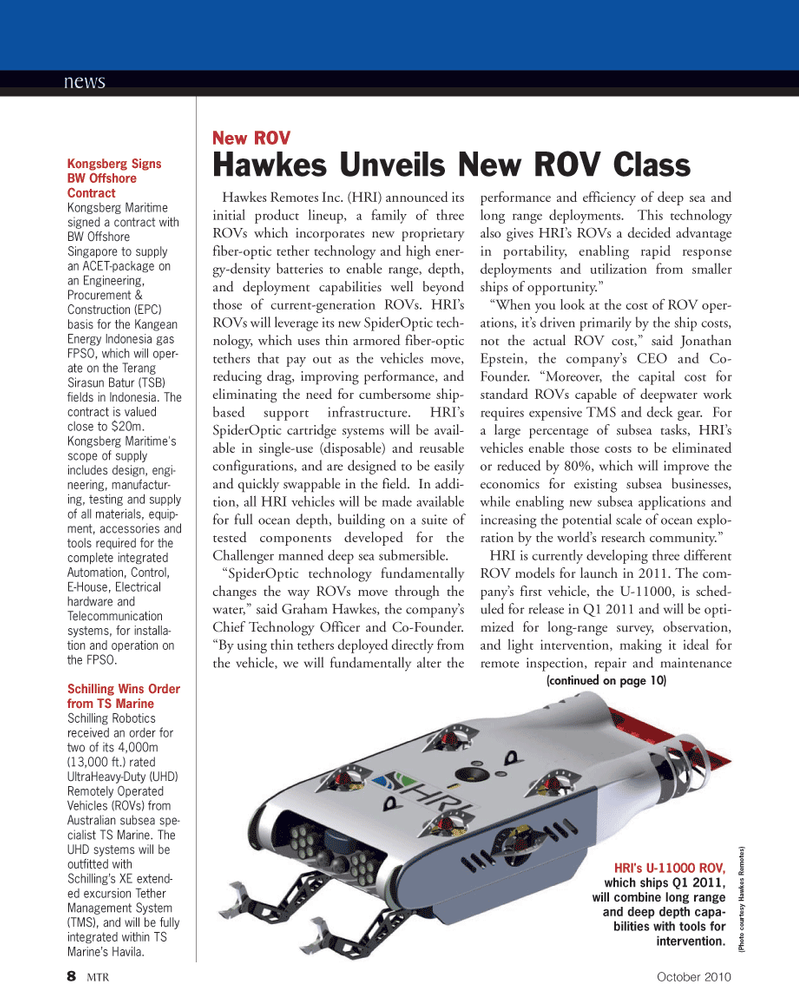
Page 8: of Marine Technology Magazine (October 2010)
Ocean Engineering & Design
Read this page in Pdf, Flash or Html5 edition of October 2010 Marine Technology Magazine
8 MTR October 2010 news
Kongsberg Signs
BW Offshore
Contract
Kongsberg Maritime signed a contract with
BW Offshore
Singapore to supply an ACET-package on an Engineering,
Procurement &
Construction (EPC) basis for the Kangean
Energy Indonesia gas
FPSO, which will oper- ate on the Terang
Sirasun Batur (TSB) fields in Indonesia. The contract is valued close to $20m.
Kongsberg Maritime's scope of supply includes design, engi- neering, manufactur- ing, testing and supply of all materials, equip- ment, accessories and tools required for the complete integrated
Automation, Control,
E-House, Electrical hardware and
Telecommunication systems, for installa- tion and operation on the FPSO.
Schilling Wins Order from TS Marine
Schilling Robotics received an order for two of its 4,000m (13,000 ft.) rated
UltraHeavy-Duty (UHD)
Remotely Operated
Vehicles (ROVs) from
Australian subsea spe- cialist TS Marine. The
UHD systems will be outfitted with
Schilling’s XE extend- ed excursion Tether
Management System (TMS), and will be fully integrated within TS
Marine’s Havila. (Photo cour tesy Hawkes Remotes)
Hawkes Remotes Inc. (HRI) announced its initial product lineup, a family of three
ROVs which incorporates new proprietary fiber-optic tether technology and high ener- gy-density batteries to enable range, depth, and deployment capabilities well beyond those of current-generation ROVs. HRI’s
ROVs will leverage its new SpiderOptic tech- nology, which uses thin armored fiber-optic tethers that pay out as the vehicles move, reducing drag, improving performance, and eliminating the need for cumbersome ship- based support infrastructure. HRI’s
SpiderOptic cartridge systems will be avail- able in single-use (disposable) and reusable configurations, and are designed to be easily and quickly swappable in the field. In addi- tion, all HRI vehicles will be made available for full ocean depth, building on a suite of tested components developed for the
Challenger manned deep sea submersible. “SpiderOptic technology fundamentally changes the way ROVs move through the water,” said Graham Hawkes, the company’s
Chief Technology Officer and Co-Founder. “By using thin tethers deployed directly from the vehicle, we will fundamentally alter the performance and efficiency of deep sea and long range deployments. This technology also gives HRI’s ROVs a decided advantage in portability, enabling rapid response deployments and utilization from smaller ships of opportunity.” “When you look at the cost of ROV oper- ations, it’s driven primarily by the ship costs, not the actual ROV cost,” said Jonathan
Epstein, the company’s CEO and Co-
Founder. “Moreover, the capital cost for standard ROVs capable of deepwater work requires expensive TMS and deck gear. For a large percentage of subsea tasks, HRI’s vehicles enable those costs to be eliminated or reduced by 80%, which will improve the economics for existing subsea businesses, while enabling new subsea applications and increasing the potential scale of ocean explo- ration by the world’s research community.”
HRI is currently developing three different
ROV models for launch in 2011. The com- pany’s first vehicle, the U-11000, is sched- uled for release in Q1 2011 and will be opti- mized for long-range survey, observation, and light intervention, making it ideal for remote inspection, repair and maintenance
New ROV
Hawkes Unveils New ROV Class
HRI's U-11000 ROV, which ships Q1 2011, will combine long range and deep depth capa- bilities with tools for intervention. (continued on page 10)

 7
7

 9
9
